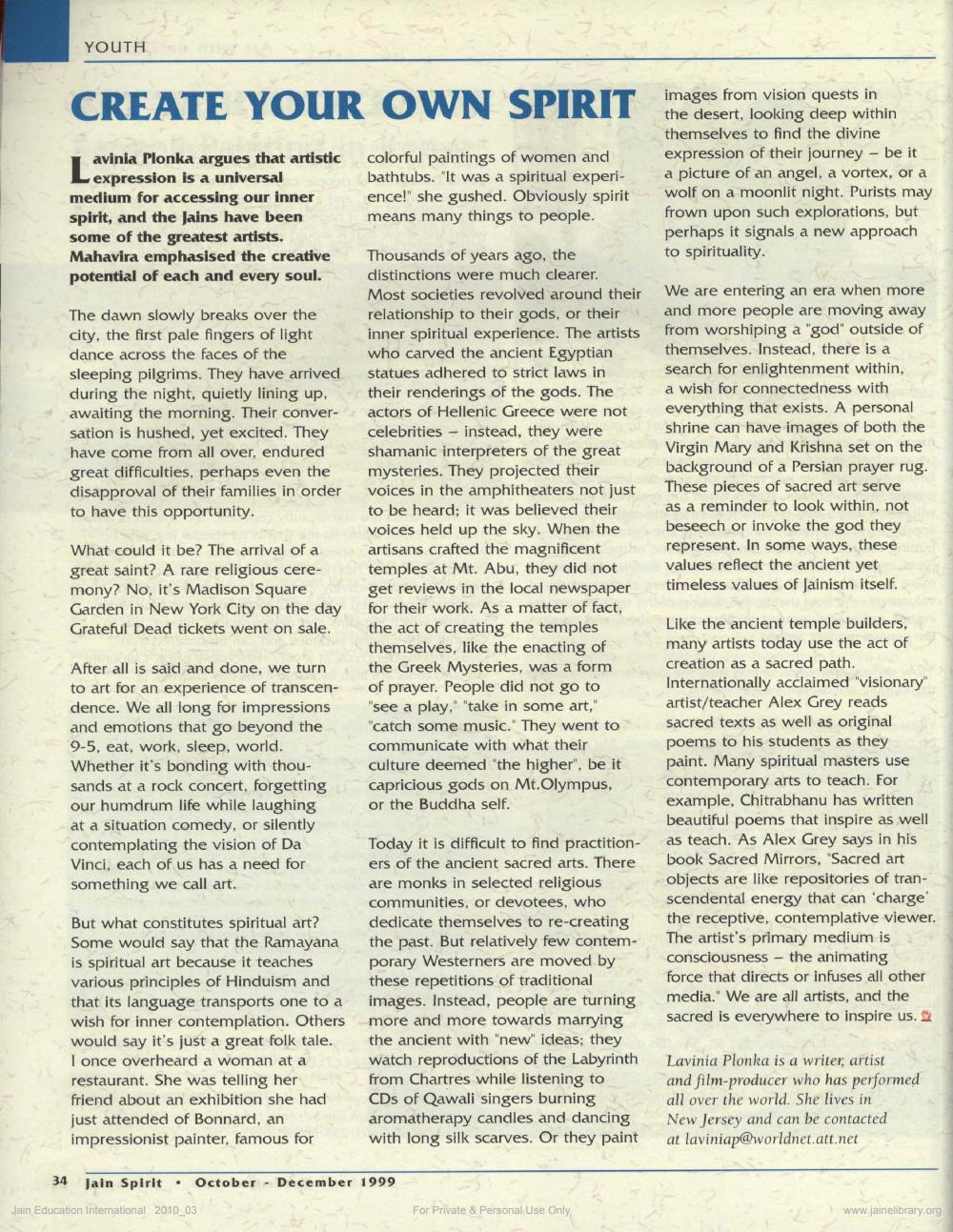________________
YOUTH
CREATE YOUR OWN SPIRIT
avinia Plonka argues that artistic
expression is a universal medium for accessing our inner spirit, and the Jains have been some of the greatest artists. Mahavira emphasised the creative potential of each and every soul.
colorful paintings of women and bathtubs. "It was a spiritual experience!" she gushed. Obviously spirit means many things to people.
images from vision quests in the desert, looking deep within themselves to find the divine expression of their journey - be it a picture of an angel, a vortex, or a wolf on a moonlit night. Purists may frown upon such explorations, but perhaps it signals a new approach to spirituality.
The dawn slowly breaks over the city, the first pale fingers of light dance across the faces of the sleeping pilgrims. They have arrived during the night, quietly lining up awaiting the morning. Their conver- sation is hushed, yet excited. They have come from all over, endured great difficulties, perhaps even the disapproval of their families in order to have this opportunity.
Thousands of years ago, the distinctions were much clearer. Most societies revolved around their relationship to their gods, or their inner spiritual experience. The artists who carved the ancient Egyptian statues adhered to strict laws in their renderings of the gods. The actors of Hellenic Greece were not celebrities - instead, they were shamanic interpreters of the great mysteries. They projected their voices in the amphitheaters not just to be heard; it was believed their voices held up the sky. When the artisans crafted the magnificent temples at Mt. Abu, they did not get reviews in the local newspaper for their work. As a matter of fact, the act of creating the temples themselves, like the enacting of the Greek Mysteries, was a form of prayer. People did not go to "see a play," "take in some art," "catch some music. They went to communicate with what their culture deemed the higher", be it capricious gods on Mt. Olympus, or the Buddha self.
We are entering an era when more and more people are moving away from worshiping a "god" outside of themselves. Instead, there is a search for enlightenment within, a wish for connectedness with everything that exists. A personal shrine can have images of both the Virgin Mary and Krishna set on the background of a Persian prayer rug. These pieces of sacred art serve as a reminder to look within, not beseech or invoke the god they represent. In some ways, these values reflect the ancient yet timeless values of Jainism itself.
What could it be? The arrival of a great saint? A rare religious ceremony? No, it's Madison Square Garden in New York City on the day Grateful Dead tickets went on sale.
After all is said and done, we turn to art for an experience of transcendence. We all long for impressions and emotions that go beyond the 9-5, eat, work, sleep, world. Whether it's bonding with thousands at a rock concert, forgetting our humdrum life while laughing at a situation comedy, or silently contemplating the vision of Da Vinci, each of us has a need for something we call art.
Like the ancient temple builders, many artists today use the act of creation as a sacred path. Internationally acclaimed "visionary artist/teacher Alex Grey reads sacred texts as well as original poems to his students as they paint. Many spiritual masters use contemporary arts to teach. For example, Chitrabhanu has written beautiful poems that inspire as well as teach. As Alex Grey says in his book Sacred Mirrors, 'Sacred art objects are like repositories of transcendental energy that can 'charge the receptive, contemplative viewer The artist's primary medium is consciousness - the animating force that directs or infuses all other media." We are all artists, and the sacred is everywhere to inspire us. 2
But what constitutes spiritual art? Some would say that the Ramayana is spiritual art because it teaches various principles of Hinduism and that its language transports one to a wish for inner contemplation. Others would say it's just a great folk tale. I once overheard a woman at a restaurant. She was telling her friend about an exhibition she had just attended of Bonnard, an impressionist painter, famous for
Today it is difficult to find practitioners of the ancient sacred arts. There are monks in selected religious communities, or devotees, who dedicate themselves to re-creating the past. But relatively few contemporary Westerners are moved by these repetitions of traditional images. Instead, people are turning more and more towards marrying the ancient with "new" ideas; they watch reproductions of the Labyrinth from Chartres while listening to CDs of Qawali singers burning aromatherapy candles and dancing with long silk scarves. Or they paint
Lavinia Plonka is a writer, artist and film-producer who has performed all over the world. She lives in New Jersey and can be contacted at
[email protected]
34 Jain Spirit • October - December 1999
Jain Education International 2010_03
For Private & Personal Use Only
www.jainelibrary.org
